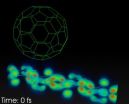(Press-News.org) TEMPE, Ariz. – Phoenix stands at a parched crossroads. Global scale climate change is forecast to bring hotter summers and more extreme heat to the Valley, but regional urbanization also will impact temperatures experienced by residents.
So how should Phoenix grow knowing that such growth could cause temperatures to increase in the future and bring added health risks? Should the city deploy mitigating technologies to help fight summer's heat? Would adopting a low-growth strategy reduce the adverse health consequences of hot weather?
New Arizona State University research examines the heat-health aspects resulting from urbanization and the challenge of sustainable future growth in Maricopa County. A study released this week shows how urban development could be a factor in the number of lives lost due to heat in future summers. The study is described in the article, "Challenges associated with projecting urbanization-induced heat-related mortality" published in the current online issue of the journal Science of the Total Environment.
"Extreme heat is the leading weather-related killer in the United States," said David Hondula, a postdoctoral scholar in health informatics in ASU's Center for Policy Informatics and lead author of the study. "In Maricopa County, we see more than 100 premature deaths and hundreds of excess emergency department visits as a result of high temperatures each summer. Understanding how different urban development strategies will impact the health risks associated with heat can help long-term planners and public officials make more informed decisions that lead to sustainable and healthy cities."
In the research, the team tried to quantify the number of excess deaths attributed to heat in Maricopa County based on three future urbanization and adaptation scenarios and multiple exposure variables. Two scenarios (low and high growth projections) represent the maximum possible uncertainty range associated with urbanization in central Arizona; a third represents an adaptation strategy by simulating the deployment of white roof technology to the area.
The researchers – in addition to Hondula included Matei Georgescu and Robert C. Balling Jr., both of ASU's School of Geographical Sciences and Urban Planning – related temperature to mortality using historical data from 1983 to 2007. Regional climate model simulations based on 2050-projected urbanization scenarios for Maricopa County generated distributions of temperature change, and from these changes in future excess heat-related mortality was estimated. They studied Maricopa County because it is a fast growing metropolitan area situated in a semi-arid region that experiences "chronic" heat during the summer months.
Overall, projections of heat related mortality ranged from a decrease of 46 deaths per year (-95 percent) to an increase of 339 deaths per year (+359 percent). Projections based on minimum temperature showed the greatest increase for all expansion and adaptation scenarios and were substantially higher than those for daily mean temperature. Projections based on maximum temperature were largely associated with declining mortality. Low growth and adaptation scenarios led to the smallest increase in predicted heat related mortality based on mean temperature projections.
Because of the environment in which it is built, increases in overnight minimum temperatures in Maricopa County associated with urbanization were found to be of much greater concern for health impacts compared to increases in daytime maximum temperatures. The same would be true in many other cities located in semi-arid regions.
"Future urbanization will lead to slightly lower summer daytime maximum temperatures in the urban core of Maricopa County compared to the surrounding natural landscape, because of the high heat retaining capacity of the built environment," Matei Georgescu said. "Continued growth would enhance this effect in the future leading to further declines in daytime highs and associated declines in health risks. The tradeoff is that nighttime temperatures increase significantly with urbanization, and this nighttime warming is much greater than the expected daytime cooling."
Hondula added that what this means for planners is that because heat impacts vary from day to night, projections of heat related health outcomes that do not consider place-based, time varying urban heat island effects are "neglecting essential elements for policy relevant decision-making."
"The manner in which the Sun Corridor develops over the next several decades will impact the regional climate and, if no new adaptation measures are introduced, change the health risks for Maricopa County residents associated with extreme heat," Hondula said. "The greatest health concern comes from large expected increases in nighttime temperatures which could be mitigated by lower-growth scenarios."
"The next step is to look more closely at the conditions people experience on hot days, to ultimately determine if high maximum temperatures, minimum temperatures, or some combination of the two is the real culprit leading to adverse health events," he added.
INFORMATION:
Source:
David Hondula
(480) 744-5818
david.hondula@asu.edu
Media contact:
Skip Derra
(480) 965-4823
skip.derra@asu.edu
Study links urbanization and future heat-related mortality
2014-05-30
ELSE PRESS RELEASES FROM THIS DATE:
DNA-binding fluorescent dyes detect real-time cell toxicity during drug screening
2014-05-30
New Rochelle, NY, May 30, 2014—High throughput screening of compounds in live cells is a powerful approach for discovering new drugs, but the potential for cell toxicity must be considered. A novel technique that uses DNA-binding fluorescent dyes to evaluate the cytotoxicity of an experimental compound in real-time during screening, saving time and resources, is described in ASSAY and Drug Development Technologies, a peer-reviewed journal from Mary Ann Liebert, Inc., publishers. The article is available on the ASSAY and Drug Development Technologies website.
Lucius Chiaraviglio ...
Study explains how green tea could reduce pancreatic cancer risk
2014-05-30
LOS ANGELES – (May 30, 2014) – Green tea and its extracts have been widely touted as potential treatments for cancer, as well as several other diseases. But scientists have struggled to explain how the green tea and its extracts may work to reduce the risk of cancer or to slow the growth of cancer cells.
A study recently published online by the journal, Metabolomics, offers an explanation that researchers say could open a new area of cancer-fighting research. The study reports that EGCG, the active biologic constituent in green tea, changed the metabolism of pancreatic ...
Research shows overall survival benefit for patients with Stage III soft tissue sarcomas
2014-05-30
CHICAGO, IL (May 30, 2014)—Fox Chase Cancer Center researchers have carried out the first retrospective analysis of adjuvant chemotherapy's impact on overall survival in patients with stage III soft tissue sarcomas (STS), adjusted for socioeconomic status and other variables. The findings show that regardless of socioeconomic status and comorbidities, adjuvant chemotherapy improved survival by approximately 23 percent in stage III STS. Study leader Sujana Movva, MD, Medical Oncologist at Fox Chase, will present the findings the 50th Annual Meeting of the American Society ...
More patients with ovarian cancer are receiving chemotherapy before surgery
2014-05-30
CHICAGO, IL (May 30, 2014)—The use of chemotherapy before surgery to remove ovarian cancer has increased dramatically in recent decades, particularly among certain patients, according to a new analysis from Fox Chase Cancer Center that will be presented at the 50th Annual Meeting of the American Society of Clinical Oncology.
Looking back at medical records from more than 58,000 women, Fox Chase's Angela Jain, MD, Medical Oncologist and co-investigator Elizabeth Handorf, PhD, member of the Biostatistics and Bioinformatics Facility, found that only 8.94% received chemotherapy ...
Compounds in saliva and common body proteins may fend off DNA-damaging chemicals
2014-05-30
A compound in saliva, along with common proteins in blood and muscle, may protect human cells from powerful toxins in tea, coffee and liquid smoke flavoring, according to results of a new study led by investigators at the Johns Hopkins Kimmel Cancer Center.
The findings, reported online May 19 in Food and Chemical Toxicology, suggest that people naturally launch multiple defenses against plant chemicals called pyrogallol-like polyphenols or PLPs found in teas, coffees and liquid smoke flavoring. The presence of these defenses could help explain why PLPs are not crippling ...
New satellite animation shows the end of Hurricane Amanda
2014-05-30
VIDEO:
This animation of visible and infrared imagery from NOAA's GOES-West satellite shows the weakening of Hurricane Amanda from May 28 to its dissipation on May 30.
Click here for more information.
A new animation of visible and infrared imagery from NOAA's GOES-West satellite shows the weakening and dissipation of the Eastern Pacific Ocean's Hurricane Amanda. The animation that runs from from May 28 to May 30 was created at NASA/NOAA's GOES Project at NASA's Goddard Space ...
Hepatitis C reactivation doesn't worsen survival for HIV+ patients diagnosed with lymphoma
2014-05-30
CHICAGO, IL (May 30, 2014)—More than a quarter of HIV+ patients are also infected with the Hepatitis C virus (HCV), which may complicate treatment and care decisions after a cancer diagnosis. The specifics of those complications haven't been well-researched in the past. Results from a new Fox Chase Cancer Center study on this patient population may start filling in that gap.
Fox Chase Hematologist and Medical Oncologist Stefan K. Barta, MD, MS, MRCP – who led the study – analyzed data from HIV+ patients diagnosed with lymphoma, collected over 17 years, to better understand ...
Identification of central nervous system involvement for patients with AIDS-related lymphomas
2014-05-30
CHICAGO, IL (May 30, 2014)—Patients with AIDS-related lymphomas (ARL) may face an increased risk of central nervous system involvement (CNSi) compared to other lymphomas. The effect of CNSi on survival outcomes, however, hasn't been thoroughly examined until now.
In a new study led by Fox Chase Cancer Center Hematologist and Oncologist Stefan K. Barta, MD, MS, MRCP, researchers report that CNSi – identified at the time of an ARL diagnosis – does not appear to have an impact on overall survival. Dr. Barta's collaborators will present the findings at the 50th Annual Meeting ...
Moffitt Cancer Center instrumental in new clinical guidelines for cancer-related fatigue
2014-05-30
TAMPA, Fla. (May 30, 2014) – Fatigue is a debilitating problem for cancer patients undergoing treatment; however, it also poses a huge detriment after treatment and can significantly affect quality of life. Approximately 30 percent of cancer patients endure persistent fatigue for several years after treatment, according to an American Society of Clinical Oncology Expert Panel co-chaired by Paul Jacobsen, Ph.D., associate center director of Population Sciences at Moffitt Cancer Center.
ASCO created the panel to develop assessment, screening, and treatment guidelines for ...
First real time movies of the light-to-current conversion in an organic solar cell
2014-05-30
VIDEO:
Real time quantum simulation of the conversion of light into current in an organic solar cell composed of a polymer chain, and a Fullerene buckyball. The movie lasts for about...
Click here for more information.
Photovoltaic cells directly convert sun light into electricity and hence are key technological devices to meet one of the challenges that mankind has to face in this century: a sustainable and clean production of renewable energy. Organic solar cells, using polymeric ...



